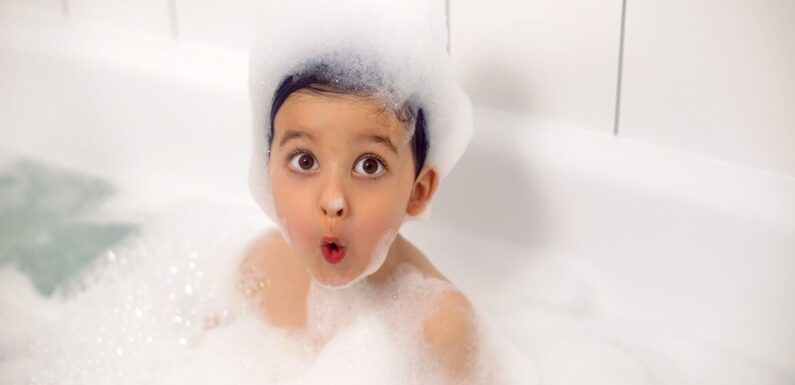
IT'S easy to think your child is only vulnerable to drowning in large bodies of water, like a pool or the sea.
But health experts have warned that it only takes a couple inches of water to put your tot's life in danger.
And all it takes is 30 seconds.
Ex-ambulance paramedic and founder of first aid education platform Safer Little Steps, Ross Smith, said "it's vital you always supervise children whether they're in or around water".
"If you're running a bath and get a phone call, don't leave your baby or toddler in the bathroom – they could drop in or fall in and drown," he told TikTok users in a video uploaded to the channel.
Every second you don't have your eye on your tot counts – so looking away to text your friends while your child is in the bath could turn deadly.
Read more on child first aid
Forgotten first aid step that could save your child’s life in an emergency
I’m a first aider – here are the 4 ‘S’ rules that could save your child’s life
Even a pet bowl filled with water could pose a risk to your little one, as they can drop their face into it while crawling, Ross added.
The first aider sought to dispel some myths about drowning, to put his warnings into context.
"[Children] don't suck a lot of water into their lungs," Ross explained.
"What happens is that they breathe back that water, it hits the back of their little airway and their airway spasms shut. Once the airway spasms shut, it only takes 30 seconds for their brain to switch off."
Most read in Health
The 11 risk factors that 'strongly predict' if you'll develop dementia
Boy, 7, born without right hand gets 'robot arm' from kind-hearted stranger
Bungling medics said wife's cancer was STI – now our boys are left with no mum
UK Covid cases nearly double in month as 2 new strains Eris & Pirola emerge
Once that happens due to lack of oxygen reaching the brain, your tot will stop breathing and become unconscious, the paramedic went on.
This is why it's vital you know what to do in a drowning emergency, Ross stressed.
He detailed what you need to do in such a situation, step by step.
1. Call an ambulance
The very first thing you should do is call an ambulance, Ross said, and listen to the call taker's advice.
2. Clear your tot's airway
"We've got to clear the airway because we know it's probably blocked full of water," was Ross's second piece of advice.
To do that, tip your child on their side to drain the water out.
3. Check breathing
Once the water has drained out, lay your little on a firm surface – like a bench, table or the floor – to check whether or not they're breathing normally.
You'll be able to tell things are OK if your little on is breathing continuously in and out, Ross demonstrated.
In this case, turn them on their side and wait for an ambulance to arrive if they're unconscious.
But if they're taking choked, small gasps, that's a sign their breathing isn't normal.
If that's the case and they're unconscious and not responding to you, move on to the next step immediately.
4. Start CPR
Start performing CPR immediately.
If your baby is up to a year old, use two fingers, position them in the centre of their chest and start pressing up and down continuously.
Do this 30 times, "at a rate of around 100-120 compressions per minute", going doing to about one third of your little one's chest dept, Ross said.
Once you've completed 30 compressions, seal your mouth over your baby's mouth and nose and "give two little puffs" of air.
"You don't want to breathe too hard," Ross cautioned. "If you breathe too hard for bubs, their tummy will blow up and some of their stomach content can come up and block their airway."
Then go back to their chest and perform another 30 compressions, followed by two more gentle puffs.
"If they start to cough and splutter and wake up, that's fantastic," the paramedic said.
"Just get them and nurse them on their side, keep your hand on the chest and their tummy to feel if they're breathing."
If they're breathing, keep them in that position till help arrives, Ross went on.
5. Keep doing CPR – you're doing more than you think
If your little one doesn't respond – "often they won't," Ross noted – it's important to keep performing CPR, as "you're doing more than you know you're doing".
By pressing into your baby's chest, "you're forcing the heart to squeeze and you're pushing blood around their brain. That blood has oxygen in it, so you're keeping their brain alive until help arrives."
You're basically resuscitating your child's brain cells, the paramedic explained.
Maintain CPR – the 30 compressions followed by two puffs – until the ambulance arrives, Ross advised.
Parents have previously shared heartbreaking warnings about the importance of supervising your child near water at all times.
One mum showed how her daughter fell headfirst into the pool while dipping her fingers in the water and would have drowned has she not quickly been pulled out.
Another warned of the dangers of 'dry drowning'.
Read More on The Sun
The One Show’s new presenter revealed & will be programme’s youngest ever host
Urgent warning for Brits travelling to Turkey amid huge sickness outbreak
And a dad told other parents to never let their little ones wear a specific swimsuit, even in a shallow paddling pool.
Source: Read Full Article










